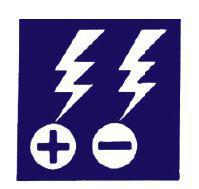SAS Urban Survival Handbook (9 page)
Read SAS Urban Survival Handbook Online
Authors: John Wiseman
Tags: #Health & Fitness, #Reference, #Survival, #Fiction, #Safety, #Self-Help, #Personal & Practical Guides, #General, #Survival Skills

It is NOT enough to know where the levers or stopcocks are. Check that you can operate them and that they do the job they are supposed to do. It is not impossible that someone has, at some time, bypassed a meter or rerouted a supply for convenience. The stopcock on the water inlet may NOT completely turn off all the water in the house. CHECK! When you switch off the electricity, is ALL the power off?
If you are in any doubt about the efficiency of the controls, or if they are very hard to get at, get them sorted out.
In a multi-occupied dwelling, some of the shared services may have only one turn-off point. Is it accessible to you at any time—day or night? If not, consider having your own controls installed. This is obviously vital in the case of gas or electricity.
ELECTRICITY
 Most of us take electricity completely for granted. We flip a switch and a light comes on. We want toast, and pop the bread in the toaster. We want food quickly and microwave ovens offer just that. There is an electrical gadget for every job, and the demand on domestic supplies is enormous.
Most of us take electricity completely for granted. We flip a switch and a light comes on. We want toast, and pop the bread in the toaster. We want food quickly and microwave ovens offer just that. There is an electrical gadget for every job, and the demand on domestic supplies is enormous.
In most houses, particularly older ones, the supply is barely up to the demand. More and more sockets are added—or worse, people start overloading sockets and adding make-do extension leads.
There are two hazards which must always be remembered when dealing with electricity—FIRE and ELECTROCUTION. Almost half of all domestic fires, some causing loss of life, are caused by electrical faults. Electrocution is less common, but still claims hundreds of lives every year.
Most common-sense precautions will protect you from both hazards. Because electricity is so dangerous, it is well worth understanding as much about it as possible.
INTRODUCTION
Electricity existed in nature before man ever thought of generating it himself and using it to his advantage. Lightning is probably the most violent and dangerous manifestation—although simple ‘static’ produced when combing your hair or the charge built up in garments during tumbledrying is also electricity. Most of us have walked across a man-made-fibre carpet and then touched something, only to receive a jolt of pain in the fingertips. This is a minor electric shock.
Even the human body is operated by tiny electrical impulses sent through the brain, nerves and muscles. This is partly why electrocution is so serious.
Man-made electricity is only useful to us when it is channelled through an appliance. When current flows through a lightbulb, the filament glows. When connected to an electric motor, the motor turns. In all appliances heat is generated—and a magnetic field. The heat may be a problem, although adequate ventilation and careful use of appliances should take care of this. Sometimes the heat generated is the whole point—as in an electric fire.
The magnetic field is usually too small to matter, unless you live in close proximity to a group of pylons or a generating station, when the powerful magnetic field may have a damaging effect on your health.
The circuit
Think of electricity as energy being pushed under pressure along a wire. The electric current flows because the pressure is greater on the side it enters an appliance—the live wire—than on the side where it leaves the appliance—the neutral wire.
The electric current moves in a circuit. If that circuit is broken, it cannot flow. By switching off a switch or unplugging an appliance, you are breaking the circuit.
The supply of electricity you receive flows from the incoming mains, through your meter and fuse box/consumer unit, along the fixed cables which are (usually) hidden in the walls, ceiling and floors. Via socket and plug or lampholder, the current flows through the live wire to the appliance, causes the appliance to do whatever it does, and then returns to the mains supply again down the neutral wire.
▶ The live wire—in some countries—is known as the active, positive or hot wire. The earth—especially in the US—is called the ground.
Conductors/insulators
The current flows through some substances more easily than through others. Substances which allow electricity to flow are called conductors. Most metals are conductors—copper, brass and aluminium are commonly used for wiring.
Substances which resist or prohibit the flow of electricity are called insulators. Most non-metals fall into this category—but in practice the most common insulators are plastics, rubber and ceramic.
For these reasons most domestic wiring is copper, which is a good conductor and flexible enough to work with. It is sheathed in waterproof plastic to restrict the flow of electricity to the copper.
Test of strength
Conductors have to be thick enough to take the amount of current passing through them. Generally, the stronger the current, the thicker the conductor has to be. The longer the run of cable, the thicker too. DON’T expect a thin cable used for wiring a battery-operated doorbell to carry a full-strength mains current. The wire will heat up, melting the insulating plastic coating and then melting itself at the weakest point—possibly starting a fire in the process!
Trying to pass a heavy current in this way is causing the wire to act like a fuse (see
Fuses
). It is also the principle of the light bulb—but the filament does not burn out because air, which is needed for combustion, is excluded from the bulb.
High voltages
Very high voltages carried in overhead cables are insulated by the air. Ceramic insulators are used to protect the pylons and the points at which the current comes down to earth. The currents carried may be as high as 400,000 volts, and are reduced at substations to be used domestically.

WARNING
Although air is a good insulator, very high voltages can ‘arc’ across quite a gap (up to 18 m/60 ft). Never fool around near overhead cables with a kite or a carbon-fibre fishing rod. You could quite easily bring the power down into your body and kill yourself.
Earthing/grounding
Electricity always wants to return to earth. This process of ‘earthing’ is what happens when you receive an electric shock from an appliance, or from a live wire. The electricity is trying to return to earth through you. The human body is not a very good conductor, but so strong is the tendency for electricity to earth itself, it will take any route offered to it. Effectively, you form a circuit.
Wearing rubber boots, which cut off the route to earth and therefore break the circuit, should protect you. Standing on wet ground makes you a more efficient circuit and is therefore deadly.
For this reason, mains circuits and most appliances carry a third wire (apart from the live and the neutral)—the earth wire. In appliances, particularly those with metal casings, the earth wire will be fixed to the inside of the casing. It is intended to offer a swifter route to earth for the electricity than you do—thereby protecting you. In reality, it does more to protect the appliance—the fuse does more to protect you (see
Fuses
).
REMEMBER
The earthing of your domestic wiring is designed to save your life and prevent fires. Do NOT tamper with it or disconnect it. It is advisable to have your earth checked every few years or after work has been done on your wiring.
The electricity should pass down the earth wire to the socket. The socket is connected to the mains supply, which is also earthed. All the earth wires on the domestic circuit should run to one heavy earth cable at the meter. It used to be quite common for the mains supply’s earth to be connected to the water pipes to guarantee a quick and easy journey for the electricity, but the introduction of plastic plumbing has rendered this method unreliable. You will still find that water and gas pipes are earthed to protect anyone touching part of these systems should any part of the electrical wiring come into contact with either of them.

WARNING
Plastic plumbing is becoming more common. This is not effective as a means of earthing your domestic electricity. If all or even part of your plumbing has been replaced with plastic, your mains supply may no longer be earthed. CHECK!
ELECTROCUTION
 It is VITAL to understand electrocution, and what to do if it occurs. Through touching an appliance which has become ‘live’ or by touching a live wire, the current is carried through the body. Since many materials, including water and even urine, are effective conductors, it is possible to receive a shock without realizing that you are in any immediate danger.
It is VITAL to understand electrocution, and what to do if it occurs. Through touching an appliance which has become ‘live’ or by touching a live wire, the current is carried through the body. Since many materials, including water and even urine, are effective conductors, it is possible to receive a shock without realizing that you are in any immediate danger.
It is quite safe to touch properly-insulated wiring in dry conditions, but use electrical screwdrivers with properly-insulated handles and stand on non-conductive surfaces—a rubber mat will do, or thick rubber boots. Do NOT touch or lean on pipes or scaffolding as there is a possibility that these could give the current an earth again.
A shock is very painful and frightening. The effects and seriousness depend on the circumstances and the individual. If the body is wet, or in wet conditions, a shock is more likely to be fatal. Most fatal shocks at domestic
voltage happen when the current passes from one hand to the other—and therefore through the heart. Expect any of the following:
- ◑ Muscle spasms which cause the victim to grip the source of current. You must NOT touch the victim or the source of the current—you will also receive a shock. You MUST sever the contact with a non-conductor—a leather belt, a stick, a piece of furniture, a piece of clothing (avoiding body contact)
- ◑ The person may have fallen and hurt themselves, or may fall when the current is broken
- ◑ The heart may have stopped beating
- ◑ Breathing may have stopped
- ◑ Severe muscle spasms have been known to break bones
- ◑ There may be severe burns
- ◑ The victim may be unconscious or even ‘dead’ (but revivable with urgent medical attention)